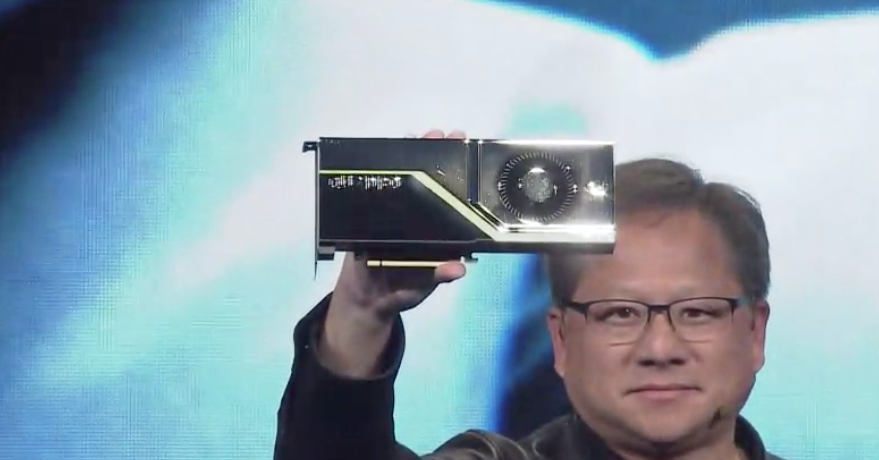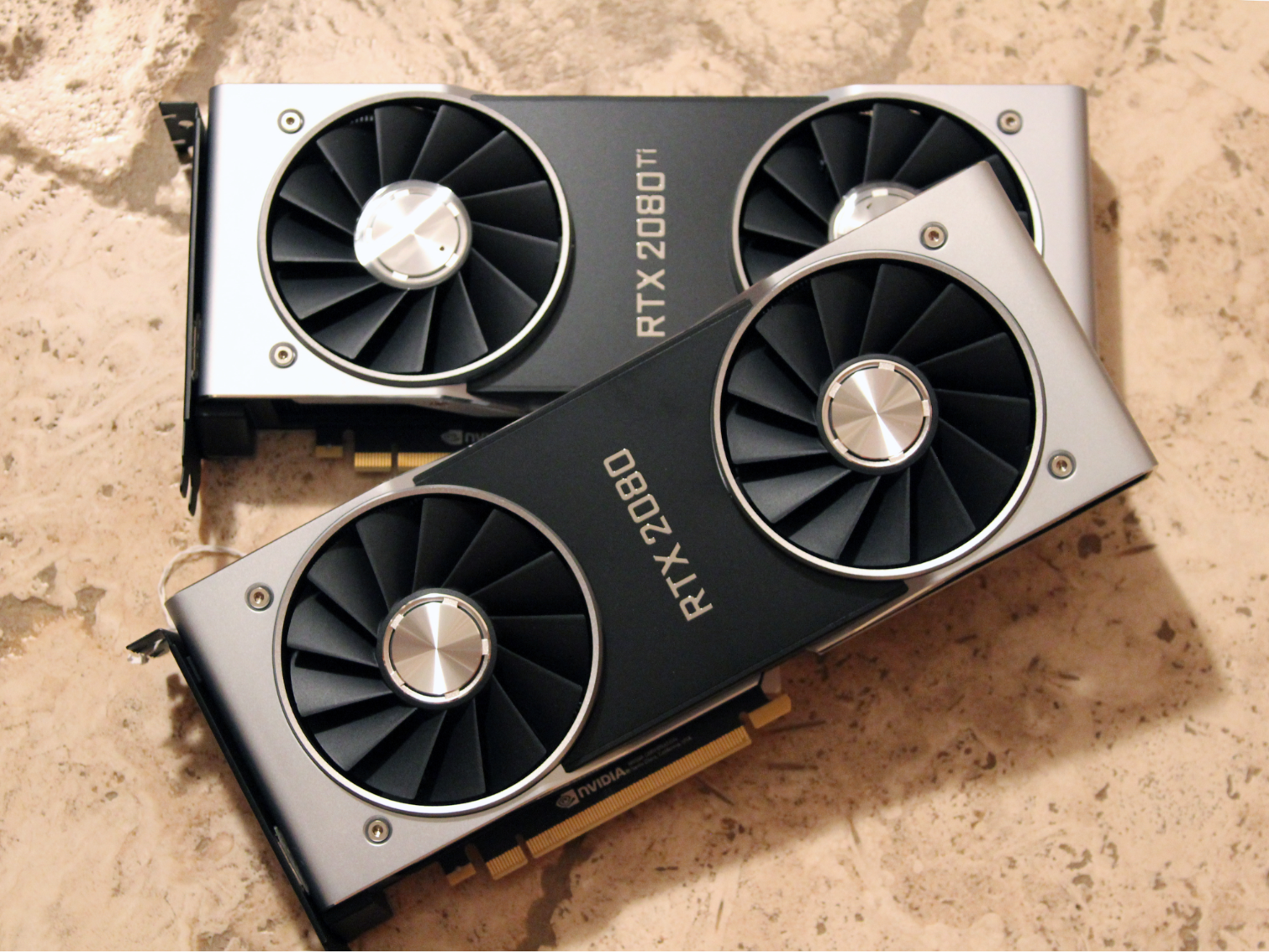We’re Still Waiting on Too Many of Nvidia’s Turing Promises
High-end PC gamers and enthusiasts are the kind of consumers most companies dream about: a collection of people eager to spend thousands of dollars on performance hardware. And two years after the well-received 10-series cards from Nvidia, a Vega response from AMD that failed to move the performance-per-dollar needle significantly forward, and enduring over a year of crypto-driven price craziness, those consumers were pretty eager for something new to get excited about.
But here we are more than two months out from the Turing launch, and Nvidia doesn’t have a whole lot to show for its effort, other than a trio of high-priced cards that are consistently failing to arrive in stores at their promised starting prices.
When Nvidia CEO Jensen Huang first announced its Turing architecture, packed with AI cores and real-time ray tracing features, he called the latter feature “the Holy Grail of our industry.” It was hyperbolic posturing to be sure—something we’ve come to expect from most major product launches--but also believable. The demos shown off by Nvidia promised a level of real-time visual realism that had only been seen before in pre-rendered cutscenes or Hollywood CGI masterpieces from studios like Pixar.
Now, Nvidia is selling its own Founders Edition cards at their promised prices, which is fine. But at the initial RTX launch, the company put up a slide showing third-party 2080 Ti cards starting at $999, 2080 cards at $699, and RTX 2070 cards at $499.
A quick look at Newegg and Amazon tells us that most RTX 2080 cards are selling for more than the premium Founders Edition pricing (north of $800 in the US and £600 in the UK), nowhere near $700. And the same is generally true of third-party RTX 2080 Ti cards—if you can find them in stock. As we wrote this on the official launch day of the RTX 2070, third-party variants of that card weren’t yet showing up for sale. And Nvidia’s own product page had a “Notify Me” button for its $599 FE variant (£549 UK), which will presumably arrive on October 17th as promised. But recent history tells us it’s extremely unlikely that we’ll see a 2070 card anywhere near its promised $499 starting price anytime soon.
Of course, card scarcity and inflated prices are nothing new for graphics card launches—I remember paying about $30 (22.74 pounds) over MSRP for my ATI Radeon HD 2600 XT in the weeks after it launched in mid-2007. But a $30 premium is a lot easier to tolerate than $100 or more.
And the high card prices are particularly hard for consumers (and reviewers) to take when the most-hyped features of RTX--namely ray tracing and AI-assisted super sampling (DLSS) can’t be definitively tested yet, because there are no games that support those features yet.
Get Tom's Hardware's best news and in-depth reviews, straight to your inbox.
We’re expecting Battlefield V in November, and though Shadow of the Tomb Raider is out now, there’s no official word on when its ray tracing features will roll out. So while Microsoft pushed its DirectX Raytracing API out in the recent October update, RTX buyers--or potential buyers--are left with a modest list of promised games for both ray tracing and DLSS, and no clear indication of just how well the new cards will run with games with these future features.
As our own Chris Angelini asked in his RTX 2070 review, “Will ray tracing make enough of a difference to compel a graphics upgrade?” That’s definitely not a question reviewers should be asking three cards into a graphics card line launch--particularly one that’s arriving more than two years after its predecessor. And rather than competition from AMD, its those still-very-available previous-generation 10-series cards that are posing the biggest argument against Nvidia’s expensive new RTX cards. Again, let’s throw to our esteemed emeritus EiC for his expert analysis:
“So, what’s up with the lackluster reception of Turing-based graphics cards? It’s a three-part interplay of hyped-up technology that can’t be used yet, comparisons to plentiful Pascal-based cards, and a resulting (negative) perception of value. In generations past, Nvidia gave us more performance at a comparable, if not better price.
This time around, the company is mostly competing against its own cards with MSRPs reflecting a lack of competition. GeForce RTX 2070 is basically a step sideways for anyone who was previously eyeballing GeForce GTX 1080. GeForce RTX 2080 is a step sideways for anyone with a GeForce GTX 1080 Ti. Only GeForce RTX 2080 Ti sets itself apart as an unrivaled winner among folks who were previously willing to pay $1200 for Titan-class frame rates. Buy Pascal or buy Turing; Nvidia wins either way.”
That last bit is key of course. While Nvidia would probably be happier if consumers picked up one of its latest cards, it’s making money either way. And without a competitive lineup from AMD--which isn’t expected at least until its 7nm Navi cards arrive sometime in 2019--Nvidia has little incentive to lower its prices.
Though it’s impossible to say yet exactly how well RTX cards are selling, clearly they are selling, as evidenced by the spotty availability of the $1,200-plus RTX 2080 Ti and the fact that third-party RTX 2080s are still mostly priced at $100 or more above Nvidia’s starting MSRP.
It’s understandable that the low availability and high prices would annoy (and in some cases, anger) enthusiasts who are used to getting more pixel-pushing power for their money. But at least there are (for the time being at least) plenty of GTX 1080s and GTX 1080 Tis available for those who don’t want to pay more for untested features such as ray-tracing and DLSS.
The bigger issue is why Nvidia is, in effect, over-promising and under-delivering with its RTX lineup--at least here in the early days of Turing card availability. Of course the company will rightly say it doesn’t have control over the price of third-party cards or when developers push out new games or updates. But with no new high-end cards from AMD on the market yet either, it’s unclear why Nvidia launched these cards when it did, rather than wait a few months. And of course it could have sold its own Founders Edition cards at slightly lower prices, pushing its third-party partners to be competitive.
We’re sure to see more than a few enticing games with ray tracing and DLSS features by 2019. By then the stock of 10 series cards may have dried up, and we’ll be able to actually evaluate the RTX cards on their key new features.
Until then, many looking for value in the high-end card market will likely keep looking to older cards--or waiting to see what AMD can deliver with Navi. Even if Navi only brings enough competition to bring down prices on today’s Turing offerings, that will be a boon for Nvidia’s sales numbers. Hopefully more RTX cards in consumers hands will also entice more game developers to push through features that take advantage of the uniqueness of Nvidia’s Turing hardware.
Note: As with all of our op-eds, the opinions expressed here belong to the writer alone and not Tom's Hardware as a team.
After a rough start with the Mattel Aquarius as a child, Matt built his first PC in the late 1990s and ventured into mild PC modding in the early 2000s. He’s spent the last 15 years covering emerging technology for Smithsonian, Popular Science, and Consumer Reports, while testing components and PCs for Computer Shopper, PCMag and Digital Trends.
-
redgarl `Hopefully more RTX cards in consumers hands will also entice more game developers to push through features that take advantage of the uniqueness of Nvidia’s Turing hardware.`Reply
Well, with AMD owning the console business and every PC games are console ports, Nvidia is not going to get a lot of support. The industry knows it, they know it and AMD knows it. -
jimmysmitty Reply21407405 said:`Hopefully more RTX cards in consumers hands will also entice more game developers to push through features that take advantage of the uniqueness of Nvidia’s Turing hardware.`
Well, with AMD owning the console business and every PC games are console ports, Nvidia is not going to get a lot of support. The industry knows it, they know it and AMD knows it.
Yet tons of games use Gameworks like the originally AMD based Tomb Raider series. Big name games too like The Witcher 3. Final Fantasy XV. Etc. Consoles don't support Gameworks yet plenty of big name games support Gameworks. Its almost as if when developing the game for PC they can and do develop for PC exclusive features especially since its was a $32billion dollar market last year.
Just to put it in perspective of $116 billion, the total for the year for gaming, it was 28% of the entire market. Consoles were 29%. Mobile gaming had vastly more with 43%. Either way PC and Console gaming were pretty much head on in terms of sales. Why would a developer not take advantage of features the majority of players probably have to get a nice slice of that pie? Answer, they will because they like to make money.
People seem to not understand that the consoles mean nothing for PC. nVidia has the better performing GPU right now and has for a while. That means sales are higher and thus more people can take advantage of those features.
While RTX sales are not going to be high at first unless AMDs Navi comes in swinging like an Irish boxer its not going to change much and once nVidia can lower costs for their refresh will still own the market and plenty of devs will take advantage of the available features.
As for the cost, this is normal. No card has ever launched, that was top of the line that is, at MSRP. If retailers can take advantage and price gouge they will. Look at crypto mining. When that was the rage and AMDs cards were great for it they were inflated to hell. You could sell used GPUs from AMD for higher than its MSRP.
Prices will settle in time once inventory channels normalize and hype blows over.
As for features, like anything it will take time and eventually catch on. I remember when DX11 first launched. Very few games supported it but slowly and surely games started to add it in and eventually more games supported it than DX9. -
kinggremlin Reply21407405 said:`Hopefully more RTX cards in consumers hands will also entice more game developers to push through features that take advantage of the uniqueness of Nvidia’s Turing hardware.`
Well, with AMD owning the console business and every PC games are console ports, Nvidia is not going to get a lot of support. The industry knows it, they know it and AMD knows it.
Nvidia doesn't develop these features and just tell developers, "Good luck." That's AMD's game plan. Nvidia heavily subsidizes developers and works with them directly to make use of their features and optimize for their hardware. Nvidia isn't dominating the AI and compute markets because of their hardware, it's because of their polished software ecosystem and all the money they pour into helping developers use their platforms. -
DavidC1 Reply21407362 said:fact that third-party RTX 2080s are still mostly priced at $100 or more above Nvidia’s starting MSRP.
Third-party manufacturers aren't stupid you know? They add more software, has better features and the cooler makes the GPU run quieter and run at lower temperatures. Why would they price it lower than the "Founder's Edition" which is really a reference design?
The reason the Turing GPUs are expensive is because Nvidia jacked up the price of the reference version with the Founder's Edition nonsense starting with Pascal. -
jas1nt Hang on a minute. Waiting for Nvidia's Turing promises? What happened to "Just buy it"?Reply
Consumer - It's too expensive.
TomsHardware - "Just buy it"
Consumer - Nothing uses Ray Tracing yet.
TomsHardware - "Just buy it"
Consumer - I don't want to have Ray Tracing when my whole life flashes before my eyes.
TomsHardware - "Just buy it"
Consumer - But I want to buy a dish washer, not a graphics card.
TomsHardware - "Just buy it" - Actually, it's not worth it at the moment. Buy a older card. it should suffice.
Consumer - I think I'll go to a different website to check for news. Thanks TomsHrdware! -
chaosmassive today articlesReply
We’re Still Waiting on Too Many of Nvidia’s Turing Promises - Matt
few days later...
We're pleased with Nvidia's Turing Performance, I Believe Nvidia's Ray Tracing Is Future, SO JUST BUY IT !, The More You Buy, The More You Save ! - Avram -
PapaCrazy Not interested in a $700 2080 blower card. I don't think we'll see many anyway because of the 215w TDP. Prices for open fan cards need to come back down to reality, below what they expect for the low end blowers.Reply



